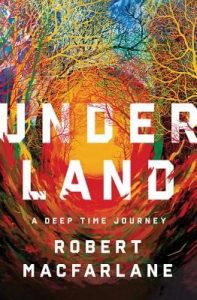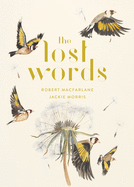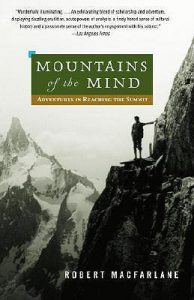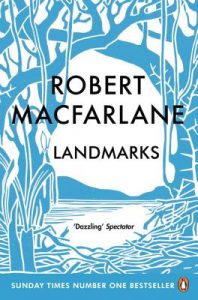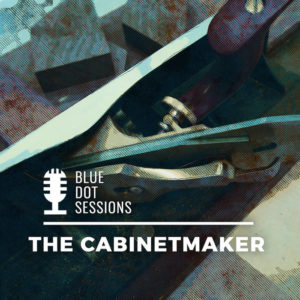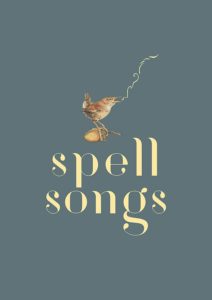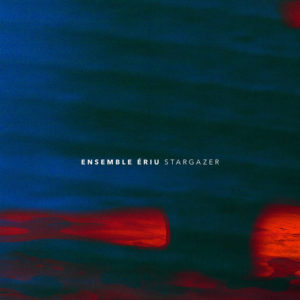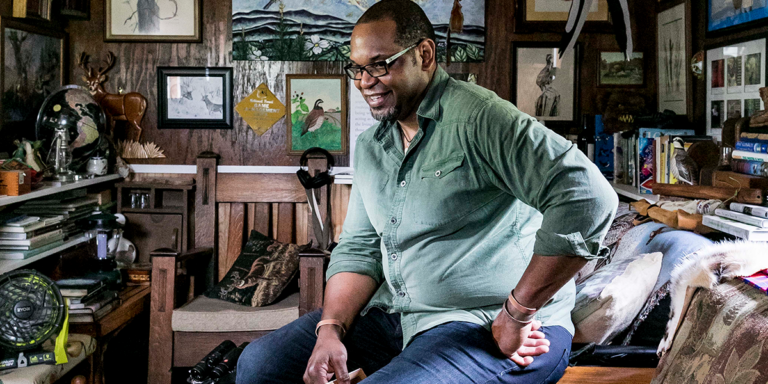Robert Macfarlane
The Worlds Beneath Our Feet
There’s dark matter in the cosmos, and inside us, and hidden beneath our feet. Robert Macfarlane is an explorer and linguist of landscape and his book, Underland: A Deep Time Journey, is an odyssey that’s full of surprises — from caves and catacombs under land, under cities, and under forests to the meltwater of Greenland. “Since before we were Homo sapiens,” he writes, “humans have been seeking out spaces of darkness in which to find and make meaning.” Darkness in the natural world and in human life, he suggests, is a medium of vision — and descent, a movement toward revelation.
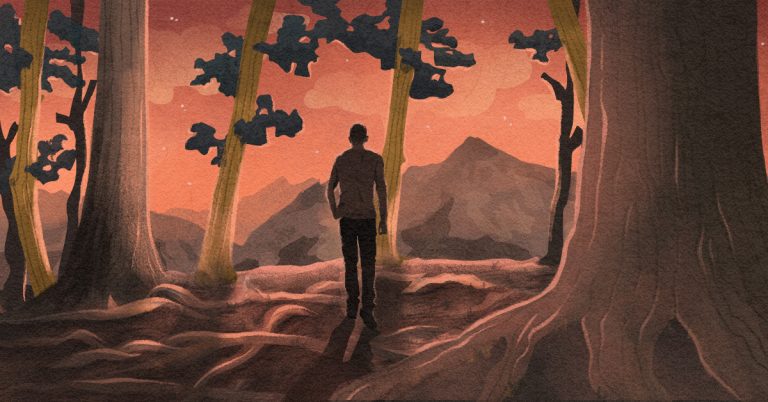
Image by Michelle Urra, © All Rights Reserved.
Guest
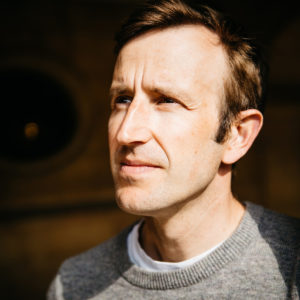
Robert Macfarlane is a Fellow at the University of Cambridge. His books include Mountains of the Mind, The Old Ways, Landmarks, and Underland: A Deep Time Journey. With the artist Jackie Morris, he co-created the book of illustrated poetry, The Lost Words and a follow-up, The Lost Spells.
Transcript
Krista Tippett, host: Robert Macfarlane is an explorer and a linguist of landscape, and I’ve loved his writing for years. His book Underland: A Deep Time Journey is an odyssey full of surprises, through caves and catacombs, under land and under cities, under forests and the meltwater of Greenland. “Since before we were Homo sapiens,” he writes, “humans have been seeking out spaces of darkness in which to find and make meaning.” Darkness in the natural world and in human life, he suggests, is a medium of vision, and descent a movement toward revelation. In a moment in which a new relationship to the ground we stand on has become a civilizational calling, Robert Macfarlane’s way of seeing the world — at once scholarly and playful, literary and enchanting — refreshes and motivates in a most life-giving way.
[music: “Seven League Boots” by Zoë Keating]
Robert Macfarlane: “Look at the gift of being, now. Look at the astonishing responsibility of legacy-leaving.” There is one image at the heart, as it were, of Underland and of the underland, which is the hand, the opened palm, the stretched fingers. And that, we know, first — is in a way the first mark of art, that the maker would place their hand on the cave wall and then take a mouthful of ochre, red ochre, often, and then spit the dust against the hand and then pull the hand away, and so you leave the ghost print. And for me, that hand of — that open hand that is reaching across time, that is pressing against rock but leaning also into the future, but also the hand of help and of collaboration — and I’ve found it everywhere.
Tippett: I’m Krista Tippett, and this is On Being. Robert Macfarlane is a Fellow at the University of Cambridge. His many books include Mountains of the Mind and The Lost Words. We spoke in 2019.
Let’s just plunge in. There’s this sentence you have: “For nearly two decades, I have been writing about the relationships of landscape and the human heart.” And I just find that such an intriguing way for you to describe your focus and that intersection. And I wonder, how would you trace the earliest, deepest roots of this? And even as I wrote that question I realized that’s kind of an Underland metaphor — but the deepest roots of this orientation in your earliest life, in the background of your life and childhood.
Macfarlane: That is a searching question, and a very good one for it. And I think whenever we find a root and follow it back, we’ll think we’ve reached its end, and it will branch off again [laughs] and surprise us. But I guess if I were to follow the first root back, it would take me into the mountains that I didn’t live in but I did in a sense grow up in. And those were the mountains of the Cairngorms in the northeast of Scotland, where my grandparents lived for many decades. And that’s really where I walked into landscape for the first time. And I have some pristinated memories from those places, where everything else from those years, those early years, is a mist. I can’t remember anything from my Nottinghamshire childhood, but I can remember picking up a roe deer’s antler that was as exotic as coral to me, from the side of a highland river. So I think that the power of that place, those arctic mountains of Britain, they grooved deep into me.
Tippett: And I also was intrigued to see somewhere a mention that your father — that you grew up in coal mining country and that your father was a lung doctor. And that juxtaposition also seemed to me to be at that point between landscape and the human heart. [laughs]
Macfarlane: Well, that’s a very — I hadn’t thought of it like that. But you’re right — it was a way that I began to look inside people, as it were. He would bring these X-rays home of people’s lungs — confidentially, obviously, not disclosing anything — but he would hold them up against the window as a lightbox. And we would — my brother and I would see into this huge space of a human lung. And he would show us the spotting that showed black lung or silicosis, and he would just talk about what had happened to the people who were working almost under our feet. And the happiest person I knew, when I was growing up, was a coal miner who was no longer a coal miner. And he taught me how to whistle, [laughs] because he loved being in the sun.
Tippett: So as I said to you before we began the official interview, I have been reading you for years, and the sweep of your writing and exploring. And I think you said it this way, in another interview — that the gradient of your body of work has been “tending downwards,” [laughs] because you began writing about mountains, in Mountains of the Mind, and then there were the valleys and moors in Wild Places, and then there’s traversing the world on foot, in The Old Ways, and now you have gone down to the worlds beneath our feet. And you said, “We know so little of the worlds beneath our feet” and I think just naming that — not something that we even think about, how little we know of the worlds beneath our feet.
Macfarlane: They are dark places in several senses. I sometimes say to my children, we walk on this thin crust above this raging space of life and matter in all its vibrancy and fury, and we know nothing of it. Our sight stops at our toes. It stops at ground level. And sight is so bound up with modern ways of knowing. We can look up and see literally trillions of miles. We can see light coming from stars across the universe, across the galaxy. But we look down, and we can’t see beyond the grass or the tarmac.
Tippett: And you went to such an unexpected array of places beneath that thin surface beyond which we can’t see. I mean, it was really stunning. I don’t know exactly what I expected when I opened the book, but I think I expected the roots of trees. I didn’t expect caves and a dark matter laboratory below the ground in Yorkshire and this subterranean alternative universe beneath Paris and burial chambers in Finland for high-level nuclear waste. And then all the way through all your adventures, there’s also this existential and elemental echo to the physical act of going downwards and into the dark.
You say that “Since before we were Homo sapiens, humans have been seeking out spaces of darkness in which to find and make meaning” and that there’s “something seemingly paradoxical: that darkness might be a medium of vision, and that descent may be a movement toward revelation.” And as you describe all of your adventures, also, even though that is true that there’s something strangely life-giving about that descent, but you over and over again not just thought about but experienced how counterintuitive it is to make that downwards move.
Macfarlane: Often, your mind is screaming at you not to enter this space, because it perceives it as a place of confinement and deprivation. And indeed, for many people, that’s what the underland has been — prisoners and forced laborers. But it has also been a place of discovery and of revelation.
And as we’ve touched on, my first love is mountains, and the first book I ever wrote tried to understand why we’re drawn upwards, often at risk of our own lives. But early on in working on this book I began to realize how young that impulse is within a Western and modern imagination. It’s only 300 years old. It’s a punk. [laughs] It’s a stripling. And yet we see, on Everest, 200-plus people queueing at 8,800 meters to get their summit selfie. And you look back to the 17th century — and it’s not absolute, but broadly speaking, there is no fetish of the summit. There is no “summit fever,” And wow, I’ve felt that fever burning in me at times, and it’s still there.
But you go back 65,000 years in western Europe, and you find Neanderthal artists going into cave spaces, hard to reach cave spaces to make art on the limestone walls of those caves. Wow. I mean, that sends a shiver down my spine across time.
Tippett: I’m feeling like, for somebody who’s listening and hasn’t read the book, I would love for them to just hear a little bit about one of the places you went. And I also — when I first started reading you, and I actually was looking for it again and I couldn’t find it, I remember reading in one of your books about how you climb trees. I found that so thrilling, to think that that is something that an adult can still do. But also I feel like you took that same freedom with your body and that same sense of curiosity, when you squeezed your body through impossible spaces. I don’t know. What’s a story that you like to tell about this underland journey, if you have to choose one?
Macfarlane: I’d love to tell you a story. I could just read you the first lines of the book, which are a story which are sort of me but are sort of every underland story. I’ve just got it here.
Tippett: Great.
Macfarlane: “The way into the underland is through the riven trunk of an old ash tree. Late-summer heatwave, heavy air. Bees browsing drowsy over meadow grass. Gold of standing corn, green of fresh hay-rows, black of rooks on stubble fields. Somewhere down on lower ground an unseen fire is burning, its smoke a column. A child drops stones one by one into a metal bucket, ting, ting, ting.
“Near the ash’s base its trunk splits into a rough rift, just wide enough that a person might slip into the tree’s hollow heart — and there drop into the dark space that opens below. The rift’s edges are smoothed to a shine by those who have gone this way before, passing through the old ash to enter the underland.”
[music: “Crem Valle” by Blue Dot Sessions]
Tippett: I’m Krista Tippett, and this is On Being, today with linguist of landscape and Underland author Robert Macfarlane.
[music: “Crem Valle” by Blue Dot Sessions]
So there’s this counterpart to the reality of the world beneath our feet, the worlds beneath our feet, which is also a huge part of the story that drew you to this and that is part of the story you tell, which is that it’s a whole frontier of what we’re discovering about what is below, but that we also live in an age, as you say, of untimely surfacings, of “Anthropocene unburials.”
Macfarlane: Yes. This history, or the future, we might say, overtook this book as I wrote it. That’s partly because I wrote it so slowly. It took six or seven years, really, to finish. But what overtook me was a sense that the underland was rising to the surface, in this restless Earth that we have made and are hastening the restlessness of around ourselves now. To give examples of what I mean by unburials, permafrost is no longer perma, it is melting and slushing, and as it does so, it’s releasing ancient methane deposits. It’s releasing the bodies of reindeer killed by anthrax, and the spores are alive and in the air again and setting off epidemics. It’s releasing 50,000 year old wolf pups in the Yukon, perfectly preserved. And structures, too — an American Cold War missile base in the northwest of Greenland is rising to the surface of the ice cap. It was left because it was thought that it would always be buried by snowfall, but now snow melt is exceeding snowfall, and so it’s coming to the light. And it’s frightening. [laughs] It’s frightening.
Tippett: And then there’s also just the phenomenon that is very ordinary of spring bulbs — of flowers coming up earlier than they should, in so many places, which is another kind of resurfacing which has beauty and yet is eerie, and it feels wrong.
Macfarlane: Exactly. Exactly. That’s wonderfully put. It has beauty but is eerie. That uncanniness of seeing things out of place, but also out of time really — it is an eeriness. It’s not a horror, but these quieter ones are — they are unsettled. There is a sense that things are unsettled.
In Britain last summer we had this drought that went on for two months. And one of the things that happened was that crop marks began to show on the parched fields. And these crop marks register the presence of old buried structures, which no one had been able to see, but they show up like a kind of X-ray — we’re back with X-rays again — on the landscape. And because people fly more drones now, more easily, suddenly people started posting this footage. They were like, “That’s a Roman watchtower,” or “That looks like a Neolithic causewayed enclosure.” And these had never been seen before, but suddenly the land was disclosing these old histories.
Tippett: Right, and a point you make is that in a larger sense these phenomena also — I think this is the way you said it — “disrupt simple notions of Earth’s history as orderly.” They have a power to shift our perception of something as elemental as time. You said, “Epochs and periods are mixing and entangling.”
Macfarlane: Yes. I mean, time — spending six, seven years thinking about the underworld has really [laughs] messed up my sense of time. It’s deepened it. It’s tangled it. But the other thing is that the underworld tells the future. And this — I was not expecting that at all. I should’ve known, because Greek myth tells us, the Sybil at Cumae, the Oracle at Delphi, they foretell the future, but they do so by peering into the underworld. And now we’re doing it scientifically. We’re ice coring down to, possibly, up to a million years ago now, in terms of data in Antarctica. And we’re using that in part to foretell our own climate futures.
Tippett: [laughs] Right. Right. In a very different context, these days — more the context of how people in this country and in your country, as well, are very socially and politically unsettled — I find it useful and in its way calming to invoke, you know, what Martin Luther King, Jr., called “the long arc of the moral universe.”
Macfarlane: Wow, what a phrase.
Tippett: And then what you bring forward, which feels to me — again, it’s a different context but it’s a corollary to this — is this notion of deep time, which also just sets our unrest — not necessarily in a soothing context but in fact in a more reality-based frame of mind, the way time works.
Macfarlane: Well, I’m glad that’s how it feels to you, because that’s how it feels to me, too. And there is a very — now to me familiar and I think ethically intolerable move that is made around deep time, which I see more and more in a kind of “climate right,” as it were, which is to say, “Oh, it’s fine. The planet’s old. It has a long time ahead of it. We’ll be gone. None of this really matters.” And for me, and it sounds like for you, put in context partly by that wonderful Martin Luther King, Jr., quotation, deep time is a sharpening context for me. It says, look at the gift of being, now. Look at the astonishing responsibility of legacy-leaving. And look at what you’ve inherited in the wonder of this world. And what will our time leave?
That, for me, is the big Anthropocene question, and it’s posed beautifully by Jonas Salk, the immunologist who invented, more or less singlehandedly, the polio vaccine and has helped eradicate that disease: “Are we being good ancestors?”
Tippett: Yes, are we being good ancestors? What a question to be asking.
Macfarlane: It’s different, isn’t it, to being a parent or a grandparent. It’s quite different, because it’s asking you to be responsible for people you not only have not met but will never meet.
Tippett: Right. It’s asking you to attend to the value of what you do and plant now, precisely for a world you’ll never see.
Macfarlane: Yes. There is one image at the heart, as it were, of Underland and of the underland, which is the hand — the opened palm, the stretched fingers. And that, we know first, is in a way the first mark of art — the hand stencil, as it’s called, which was made in early cave art by — the maker would place their hand, his or her hand, on the cave wall and then take a mouthful of ochre, red ochre, often, and then spit the dust against the hand and then pull the hand away, and so you leave the ghost print. And it’s such an image. And for me that open hand, the hand that is reaching across time, that is pressing against rock but leaning also into the future, but also the hand of help and of collaboration — and I’ve found it everywhere, actually. It astonished me. I met such kindness, such collaboration, such readiness to reach out.
Tippett: Yes, that is so much a part of the story that you tell — of the hospitality that greets you everywhere.
Macfarlane: Hospitality, that’s a wonderful — yes, that’s exactly right.
Tippett: I do want to speak also about language and the power of words and the magic of words that I feel you surface in your writing and also in your investigations. Even the word “discover,” somewhere I learned in your writing, has this underland connotation, right — “to reveal by excavation; fetch up from the depths.” The book where you, I think, have focused most explicitly — I mean, this runs all the way through your writing, and thinking about the book Landmarks, I think it is just kind of devoted to that. It makes me think of how in sacred traditions, naming has this power. And in Genesis, the original creative act, next to making order out of chaos, is calling things into being by giving them names. There’s a place where you were writing about — I think the Isle of Lewis and an Apache tribe in Arizona, and you said, “Words act as a compass. Place speech serves literally to enchant the land; to sing it back into being and to sing one’s being back into it.”
Macfarlane: Yes, well, the first thing I should say in response to that fine thought is that not all naming is good naming. There is bad naming, and naming can, as we know, be an appropriative act of conquest and overwriting. And the control of naming —
Tippett: Yes, well, I think that’s the other side of that power, right?
Macfarlane: The power, exactly. It is such a foundational act, to give name to. And with names, often, they are — call them portals to love and care. We rarely care for what we cannot name. I became fascinated, over four years in the mid-2010s, if I can call it that historically — a few years back, let me say — by lexis for landscape and the sense that we were making do — certainly in British English, increasingly — with a generic portfolio of “hill, field, wood, river, stream, town.” And I sensed — I knew that there was this word hoard there within the wonderful diversity of languages and dialects, subdialects we have in these islands, and this was particularly focused, for me in the beginning, in Gaelic — what we might call Scottish Gaelic, but Gaelic, effectively. And so to give some examples from the moorland language of the Outer Hebrides, “rionnach maoim” means, in long form, “the shadows cast on moorland by clouds on a sunny day.” [laughs] And there is a drama unfolded out of this two-word phrase, in the mind’s eye.
Tippett: You’ve uncovered probably hundreds, certainly, perhaps thousands.
Macfarlane: It was about two thousand probably, in the first edition, and then two-and-a-half thousand because people began to send me — [laughs] these letters would pour in from around the world, around Britain, as postcards like feathers coming.
Tippett: I feel also that this adventure you’ve been on is also full of the realities and discoveries that — things that we’re only now learning to see in order to put words around. It feels to me like one of those things — I don’t know if this is new to you, but it was new to me — just the way you describe about the connection between ice and the nature of ice and memory, that “ice has memory, and the color of this memory is blue,” that “ice remembers in detail, and it remembers for a million years or more. Ice remembers forest fires and rising seas. Ice remembers the chemical composition of the air around the start of the last Ice Age.” Was that a discovery to you?
Macfarlane: I am a cryophile. I love ice with all my warm-blooded heart, and I always have done. And so it wasn’t a surprise to me. But delving into the science of that memory, if we can call it that, was a revelation. And I remember standing in a cold store — I’m in Cambridge; that’s where I teach, and just nearby we have the British Antarctic Survey, which is the heart of polar science really, in Britain. And I went into this cold store with Robert Mulvaney, a climate scientist, glaciologist, and he took out a section of core that had come up from deep down in the Antarctic ice cap. And then he took out a slice of it and held it up. And it’s like looking into a planetarium or a night sky. It sparkles, this stuff, and the sparkles are bubbles. And the bubbles are air that was trapped when this ice fell as snow and softly, softly caught air in its layers. And as the ice gets buried, so the air gets compressed into these bubbles. And the bubbles are memory. They remember what the atmosphere was like, what it contained at that time. And I love this thought of ice as having a memory. And we’re learning now to read that memory, to recover that memory even as the memory itself is being lost through melt.
Tippett: Another thing that I learned through reading you is that even in the last couple of years there’s been this revelation of what you called a “deep life ecosystem in the Earth’s crust that is twice the volume of the world’s oceans, containing a biodiversity comparable to that of the Amazon.”
Macfarlane: [laughs] What about that, eh? I mean, it’s just — this all came out after a five-year research project disclosed its findings in, I think, about nine months ago. And so yeah, guys, there’s — folks, there’s an entire ecosystem down there, which dramatically exceeds in biomass the entire human population of the Earth at present. It is incredibly diverse. And it goes seven miles down and probably more. I mean, what about that for a declaration of how little we know?
[music: “Paper Tiger” by Helios]
Tippett: After a short break, more with Robert Macfarlane.
[music: “Paper Tiger” by Helios]
I’m Krista Tippett, and this is On Being, today with Robert Macfarlane. He’s written about the human fascination with mountains, the old way of knowing land by walking it, and he’s a lyrical excavator of lost words for the natural world. In his newest literary adventure, Underland, he explores the hidden worlds beneath our feet. We’ve been talking about the world of emerging discoveries about that.
Another whole new — it’s like a whole new planet in our midst — is this language of the wood-wide web.
Macfarlane: The wood-wide web. Would that that were my phrase, but it is not. Did you — was that fresh to you, this revelation of the wood-wide web?
Tippett: No — I mean, I don’t know if I’d heard that phrase before or not. I have been aware of this — it’s kind of what we’re learning about trees and forests and things like fungi and mosses, which were things we thought of as parasites, it turns out are essential to vitality.
Macfarlane: And collaboration.
Tippett: Collaboration, the mutuality of everything.
Macfarlane: This glorious mutualism, which is about 450 million years old, we think, because a fossil photograph — lithograph, effectively — exists from around then, showing it in action, whereby fungi, certain fungi, ecto- and endomycorrhizal fungi plug into the roots of trees and plants at a cellular level and create an interface across which resources and messages, to some degree, can be carried. And then those fungi plug into the roots of other trees, and so the trees can — as Suzanne Simard, the pioneering forest ecologist who helped break open this ground writes — can talk to one another. And once you’ve met this idea, wow, it shakes the ground you walk on. A park is a wondrous place. But it also challenges our ideas of what an individual is, what an organism is, where being begins and ends — it does not end at the body horizon, we know that increasingly and in complex and often political ways.
Tippett: There was a — you were describing a conversation, in Underland, with Martin Sheldrake in Epping Forest.
Macfarlane: Merlin, the wonderfully named Merlin Sheldrake.
Tippett: Merlin, sorry, Merlin. And you quoted him — it was just fantastic — as saying, “My early superheroes weren’t Marvel characters, but lichen and fungi,” and that they “annihilate our categories of gender. They reshape our ideas of community and cooperation. They screw up our hereditary model of evolutionary descent. They utterly liquidate our notions of time.” [laughs]
Macfarlane: [laughs] What’s more superhero than that?
Tippett: I think that you’re also making — circling back around where we have circled around in this conversation. Let me say this — we were speaking a minute ago about places we find hope and new imagination for new realities forming. And I do experience — and every good word gets overused in human cultures, so I feel like now the word “ecosystem” is being overused. But it’s a tectonic shift, really, in thinking about how institutions work and leadership works and how things happen — how movements work, how forms are changed, how minds are changed, how we work together to create new realities. It does feel to me like these kinds of discoveries about how reality works, how life works, are not only relevant to how we’re reimagining — I think somewhere you said “historical narratives of progress” — but also remaking how we structure our life together.
Macfarlane: I hope so, Krista. I really hope so. At the core of them is something a bit more complex than just connection. It’s entanglement. And for me, entanglement is different to connection because connection is purely a structural effect. But entanglement is — as it were, requires a mutualism to be recognized; that there are consequences of entanglement; that if one thing is destroyed or leaned too heavily on or exhausted, then this will recoil, as it were. And we have too long thought of ourselves as an arrogant species that can draw on the world as inexhaustible standing resource, whether that be to provide or to accept that which we dispose of. And that relies on a very monadic notion of being. And these revelations of entanglement, they destroy those ideas and they show us to be profoundly porous — to be nothing but holes, almost, and string.
I think Donna Haraway, whose work you will know, she talks about “making kin.” And another lovely word she has is “sympoiesis.” So “poiesis” has that sense of creation, of creating, but “sym” gives us that “creating with” — so the idea of making kin and of sympoiesis. And for Haraway, working with Lynn Margulis, this is happening at a genetic level, an epigenetic level, as well as at a creative and communal and societal level. So it has form [laughs] as a way of proceeding, if you like. Life has always literally flourished and grown through co-making.
Tippett: OK, this is a turn — Minecraft. [laughs] I was so surprised — and this just reveals the limits of my knowledge — that you wrote a piece about Minecraft and you started it by saying, “The imaginary landscape in which I spend most time is born not of a book or a film but of an algorithm.” And I guess you spend time in Minecraft with one of your children, or with your children?
Macfarlane: [laughs] Yeah, when I wrote that short piece about Minecraft, I was spending a great deal of time in that underworld. [laughs] And it was also the time when I was in physical underlands a great deal, and I just — I became fascinated by it as this virtual realm. Of course, people have written about how it is a sort of parable of extractive human progress. You’ve got to get down there and mine your resources and build and build and build. But it also has this realm, this mythic realm called the Nether. [laughs] And the Nether is what you pass into through a portal that you construct out of obsidian. And the Nether is all our underlands rolled into one. And so I found myself [laughs] — sometimes I would come back from these trips into nuclear waste storage facilities or cave systems, and then I would be sitting down with my kids, and they’d be like, “Let’s go to the Nether, Dad!” And I’d say, “I’ve just come back from there.” [laughs]
[music: “Polycoat” by Blue Dot Sessions]
Tippett: I’m Krista Tippett, and this is On Being, today with Robert Macfarlane. His book Underland is an odyssey full of surprises through the hidden worlds beneath our feet — from caves to the meltwater of Greenland to physicists searching for the nature of dark matter in an underground laboratory in Yorkshire.
[music: “Polycoat” by Blue Dot Sessions]
So you’ve also said that “What started as a journey into pure matter” became, to your surprise, “an exploration of hidden human depths, both wondrous and atrocious. We all carry underlands within us, but only rarely acknowledge their existence.” And it does seem to me, with so much in the landscapes you explore and also the science you explore around it, the discoveries we’re making speak to and illuminate the depths of human experience.
Macfarlane: Well, it’s lovely to hear you say that. They illuminate only a few parts of them, of course, and only the corners I can see when I raise the taper to my eyes. But I guess when I’m alluding to that sense of the underlands we carry with us, that, for me, is trauma, it’s lost memories or buried memories in some sense. So that’s, as it were, the dark matter in —
Tippett: Right, the dark matter in us … [laughs]
Macfarlane: [laughs] In us.
Tippett: … where the light does not intersect. [laughs]
Macfarlane: Yeah, yeah, and either we can’t bring those things to the light, or we choose not to. And I did — and there’s a chapter in the middle of Underland which takes place up in the Slovenian-Italian limestone borderlands, which was the darkest place I’d ever been. That’s about some of the reprisal killings that were carried out really using the landscape as a means of execution and a means of disposal, in the closing years of the Second World War. And the sinkholes in the cast limestone landscape there became a place where people were taken to and pushed into, either alive or wounded or dead. And bodies and bones are still being recovered from these places. It’s extremely disputed, complex, highly politicized history that is still itself unburying again and again. It’s an unclosed wound in that part of Europe. And that was a terrible place to come to terms with. And that’s really where the heart of the horror is. And then oddly, hope was found in a nuclear waste storage facility where people were trying to do the best they could.
Tippett: In Finland.
Macfarlane: In Finland, that’s right.
Tippett: There was moment where you’re having this conversation with this very intriguing young physicist named Christopher Toth — is that right? And you ask him, “Why are you searching for dark matter?” And he says — and I think you say, “without hesitation” — “To further our knowledge and to give life meaning. If we’re not exploring, we’re not doing anything, we’re just waiting.” And then you said to him, “Is it an act of faith?” [laughs]
Macfarlane: Well, it’s — yeah. It’s partly because we were close to Rievaulx Abbey, which is one of the great Cistercian abbeys of my country. And I’d driven past it earlier that day, and I just suddenly realized that the monks sending their prayers up to an unseen God had such strong echoes, for me, with these scientists in their extraordinarily constructed, in this case sort of crypts cut into 270 million-year-old rock salt, a mile underground, almost. And they too were scrutinizing the universe for messages from an unseen, unknown presence — [laughs] beautifully faithful, both, across 700 years.
Tippett: There’s some words, also — you said that “Since before we were Homo sapiens, humans have been seeking out spaces of darkness in which to find and make meaning” and that there’s “something seemingly paradoxical” in that, “that darkness might be a medium of vision and that descent may be a movement toward revelation.” And it feels to me like that for you, personally, there was something in that.
Macfarlane: Well, I definitely was more changed and learned more about myself and, I think, about the world more broadly speaking, if I can call it that, from the years of this book than any other. And that may have something to do with being 43, 37 when I began it, 36. And when you were reading those words I was remembering being in the Cave of the Red Dancers, which is this sea cave in arctic Norway hard by a huge whirlpool that is known as The Maelstrom, which gives us that word that is now a generic for whirlpools. And so there are two entries, one into the mountain and one into the sea, right by each other. And in what we might call the Bronze Age, 2,000 to 3,000 years ago, people traveled to that hard, hard place, and they made art in the darkness, red dancing figures that leaped on the walls of that sea cave. And they crossed two thresholds. They crossed the threshold of entering the cave, and then they crossed the second one, which is in a way the more powerful one, which is where light gives way to darkness. And it was in — once they’d crossed that second threshold that they began to paint.
And that, to me — I mean, I wept. I wept when I saw those figures, partly because it had been such a hard winter journey to get to them, but also time shifted in ways I’ve never really experienced before, in that space.
Tippett: You’re now, I understand, doing some work in hospitals in the UK to bring nature into the lives — tell me about that.
Macfarlane: Oh, I’m glad that’s crossed your path. Yes, this arises from a book called The Lost Words that I made with Jackie Morris, which has been the wildest thing I’ve ever been involved with, in the sense that you plant an acorn, and a wild wood springs up around it. The simplest form of the book is just 20 words that fell out of a widely used children’s dictionary because they weren’t being used enough, and they were words for nature: acorn, bluebell, kingfisher, conker, wren, willow. And so, we just wanted to make a spell book that might conjure them back.
But hospitals have taken the art and taken the spells and have designed them — floor to ceiling across four stories, for example, of a new orthopedic rehabilitation hospital in North London, and also in a critical care unit in Wales — and they’re actually becoming part of the healing work that’s done. So where young children who are recovering from orthopedic difficulties, they walk the corridors, doing their physio. And so Jackie would put a tiny mouse in each panel of the murals, and the children would move a little further each time to find the mouse hidden among the buttercups and the moths. Really it’s about nature much more than the book. The book is just a catalyst for that.
Tippett: Makes me think of work that’s being done, studying — in hospitals, also — that if people have a window and can see a tree outside the window, their healing is accelerated — that their outcomes — right?
Macfarlane: Yeah.
Tippett: I’m curious about the language of spell book and spell songs. There’s an album that goes along with the book, which I just started listening to last night, and it’s so beautiful.
Macfarlane: Oh, I’m so glad you think so.
Tippett: Oh, it’s so beautiful. So where did — tell me about that language of spells. Where does that emerge from?
Macfarlane: Well, I could read you a quick one. That’s probably the best way to instantiate it. I did bring it. Spells are there to be spoken. They have an oral power. They’re utterances. And I’ve always loved reading aloud and writing to read aloud, as it were. And so in that sense, I wanted to write a language that tumbled on the tongue and turned around. And this is “Wren.” The wren is this tiny, quick-moving bird. We hardly see them in this country, though there are 8 million breeding pairs of them, because they move so fast, they seem to teleport. So here goes “Wren”:
“When wren whirs from stone to furze the world around her slows, for wren is quick, so quick she blurs the air through which she flows. Yes. Rapid wren is needle. Rapid wren is pin. And wren’s song is sharp song, briar song, thorn song. And wren’s flight is dark flight, flick flight, light flight. Yes. Each wren etches, stitches, switches, glitches. Yes. Now you think you see wren. Now you know you don’t.”
Tippett: I feel like we’ve been speaking about this the entire time, but I’m curious about how this adventure, this investigation, and just these things you’ve been thinking about these years — this is a ridiculously large question, so just how you would begin to reflect on it — how this has changed the way you think about life and death and what it means to be human, how you move through the world, how you parent differently.
Macfarlane: Well, in a way I can’t remember what it was like before beginning this river run, because each book flows really into the next and out of the last, as it were. So it started 20 years ago, and I don’t have much memory from before that. But I guess — I mean, I am — as you said at the beginning, landscape and the human heart, this is to me an inexhaustible and eventually unmappable terrain. And of course, the heart is a many-chambered thing, and some of those chambers hold hate, but it also activates love and grace and joy.
But I think most, when you ask me that question, about my six-year-old, who features as a four-year-old quite a lot in Underland. And I took him up to these spring sites near our house, where the book ends, the book surfaces. But we went back not so long ago. But there — they should be a place of life where water rises from, wells up from within the ground. But they were dead. There was nothing. There was no life. They’d shrunk to a puddle and a mud bath. And this is because of over-extraction, water that we use in our household, but also an Anthropocene drought, really, that’s gripping the southeast of England in the longer term. And he doesn’t really understand any of that stuff, obviously, but it just struck his soul to see a spring site dry. And he came back so forceful, so clear about what needed to be done. And he has been on our case about water use ever since. And so it was such a fascinating moment for me, to watch this encounter with an absence translate itself into a sort of — the politics of a six-year-old, as it were.
So I think, be out, get out, look up, walk where and when you can, and be curious, and be astonished by the world. Live in what John Muir called a storm of wonder for a few minutes or a few hours each week. [Editor’s note: John Muir writes about a “storm of beauty.”]
[music: “The Lost Words Blessing” by Julie Fowlis, Karine Polwart, Seckou Keita, Kris Drever, Rachel Newton, Beth Porter, Jim Molyneux and Kerry Andrew]
Tippett: Robert Macfarlane is a Fellow at the University of Cambridge. His books include Mountains of the Mind, The Wild Places, Landmarks, The Lost Words, and, most recently, Underland: A Deep Time Journey.
[music: “The Lost Words Blessing” by Julie Fowlis, Karine Polwart, Seckou Keita, Kris Drever, Rachel Newton, Beth Porter, Jim Molyneux and Kerry Andrew]
This is “The Lost Words Blessing” from the album Spell Songs, which was created by eight musicians in the British Isles to accompany Robert Macfarlane’s book and work to “conjure back” lost words and landscapes.
[music: “The Lost Words Blessing” by Julie Fowlis, Karine Polwart, Seckou Keita, Kris Drever, Rachel Newton, Beth Porter, Jim Molyneux and Kerry Andrew]
The On Being Project is located on Dakota land. Our lovely theme music is provided and composed by Zoë Keating. And the last voice that you hear singing at the end of our show is Cameron Kinghorn.
On Being is an independent, nonprofit production of The On Being Project. It is distributed to public radio stations by WNYC Studios. I created this show at American Public Media.
Our funding partners include:
The Fetzer Institute, helping to build the spiritual foundation for a loving world. Find them at fetzer.org.
Kalliopeia Foundation, dedicated to reconnecting ecology, culture, and spirituality, supporting organizations and initiatives that uphold a sacred relationship with life on Earth. Learn more at kalliopeia.org.
The Osprey Foundation, a catalyst for empowered, healthy, and fulfilled lives.
The Lilly Endowment, an Indianapolis-based, private family foundation dedicated to its founders’ interests in religion, community development, and education.
And the Ford Foundation, working to strengthen democratic values, reduce poverty and injustice, promote international cooperation, and advance human achievement worldwide.
Books & Music
Recommended Reading
The On Being Project is an affiliate partner of Bookshop.org and Amazon.com. Any earnings we receive through these affiliate partnerships go into directly supporting The On Being Project.





